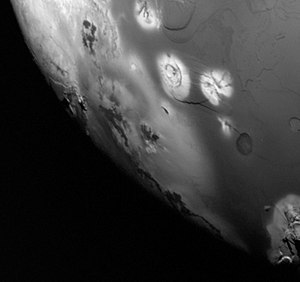Masubi (volcano)

Masubi is an active volcano on Jupiter's moon Io. It is located on Io's leading hemisphere at 49°36′S 56°11′W / 49.6°S 56.18°W within a bright terrain region named Tarsus Regio.[1] The volcano was first observed during the Voyager 1 encounter with the Jupiter system on March 5, 1979. Voyager found 64-kilometer tall, 177-kilometer wide volcanic dust plume, composed primarily of sulfur dioxide, at the northern end of a 501-kilometer long dark lava flow.[2][3] To date, images taken by Voyager 1's Imaging Science Sub-system Wide-Angle Camera shortly before the spacecraft's closest approach to Io have the highest spatial resolution coverage of this volcano at two kilometers per pixel.[4] These images reveal a lava flow with a V-shaped northern end, associated with the plume source as noted by the dark plume deposit ring surrounding it, and bifurcated southern section.[4] The two-lobed shape of the plume deposit may result from the Masubi volcanic plume during Voyager 1 encounter having two sources on the flow field and two eruption columns.[5] This faintest of Io's plumes observed by the two Voyager spacecraft, initially designated as Plume 8, was formally named Masubi, after a Japanese fire god, Ho-Masubi, in 1979 by the International Astronomical Union.[1] The lava flow associated with the plume was named Masubi Fluctus shortly after the start of the Galileo mission.
The Galileo spacecraft and ground-based astronomers observed volcanic activity at Masubi on several occasions in the late 1990s, but it was not a persistent thermal hotspot.[6] The camera on Galileo observed a volcanic plume along Masubi Fluctus during the Galileo extended missions, in July/August 1999 and August 2001.[7] Galileo's cameras also observed a plume deposit form in September 1997. In each of these cases, the volcanic plumes emanated from different parts of Masubi Fluctus, providing further evidence that plumes like Masubi eruption along active flow fronts that interact with surficial sulfur dioxide frost, rather than erupting from the primary volcanic vent.[8] Ground-based astronomers in August 1998 briefly observed a high-temperature eruption at Masubi, confirming Masubi Fluctus' silicate mafic to ultramafic composition.[9]
Masubi was last observed by a spacecraft during New Horizons' February 28, 2007 encounter with the Jupiter system. During this encounter, two plumes were observed along Masubi Fluctus at the northern end of the flow, interpreted as the main source vent for the flow, and another near the middle of the elongated flow field.[10] These two plumes were 70 and 80 kilometers tall, respectively. New Horizons also observed a fresh, 240-kilometer lava flow at Masubi, the largest new lava flow observed on Io or anywhere in the solar system since volcanism was discovered on Io in 1979.[11] The two plumes observed emanate from the northern and southern ends of this new flow.
References
- ^ a b Blue, Jennifer (October 1, 2008). "Io Nomenclature: Eruptive center". USGS. Retrieved 2008-10-01.
- ^ Davies, Ashley (2007). "Io, 1610-1979". Volcanism on Io: A Comparison with Earth. Cambridge University Press. pp. 7–26. ISBN 0-521-85003-7.
- ^ Strom, R. G. (1979). "Volcanic eruption plumes on Io". Nature. 280: 733–736. doi:10.1038/280733a0.
{{cite journal}}: Unknown parameter|coauthors=ignored (|author=suggested) (help) - ^ a b Perry, Jason (March 9, 2009). "Taking another look at Voyager 1 images of Io". The Gish Bar Times. Retrieved 2010-01-30.
- ^ Perry, Jason (March 8, 2009). "30th Anniversary of the Discovery of Volcanism on Io". The Gish Bar Times. Retrieved 2010-01-30.
- ^ Lopes, R. M. C. (2001). "Io in the near infrared: Near-Infrared Mapping Spectrometer (NIMS) results from the Galileo flybys in 1999 and 2000". Journal of Geophysical Research. 106 (E12): 33, 053–33, 078. doi:10.1029/2000JE001463.
{{cite journal}}: Unknown parameter|coauthors=ignored (|author=suggested) (help) - ^ Geissler, P. E. (2008). "Galileo observations of volcanic plumes on Io". Icarus. 197: 505–18. doi:10.1016/j.icarus.2008.05.005.
{{cite journal}}: Unknown parameter|coauthors=ignored (|author=suggested) (help) - ^ Phillips, Cynthia (October 7, 1999). "Migrating Volcanic Plumes on Io". Planetary Image Research Laboratory. Retrieved 2010-01-30.
- ^ Geissler, Paul (2003). "Volcanic Activity on Io During the Galileo Era". Annu. Rev. Earth Sci. 31: 175–211. doi:10.1146/annurev.earth.31.100901.145428.
- ^ Spencer, J. R. (2007). "Io Volcanism Seen by New Horizons: A Major Eruption of the Tvashtar Volcano". Science. 318: 240–43. doi:10.1126/science.1147621.
{{cite journal}}: Unknown parameter|coauthors=ignored (|author=suggested) (help) - ^ "Changes on Io". New Horizons: NASA's Pluto-Kuiper Belt Mission. October 9, 2007. Retrieved 2010-01-30.

